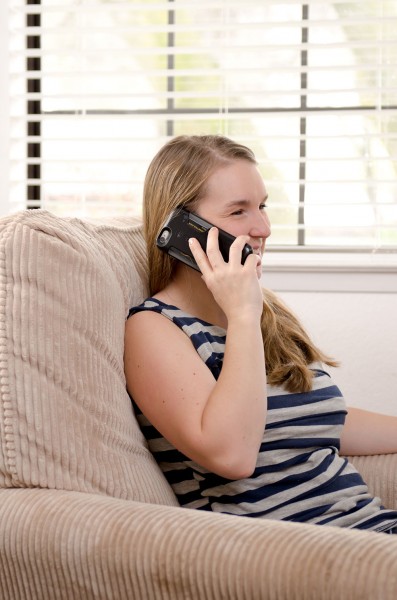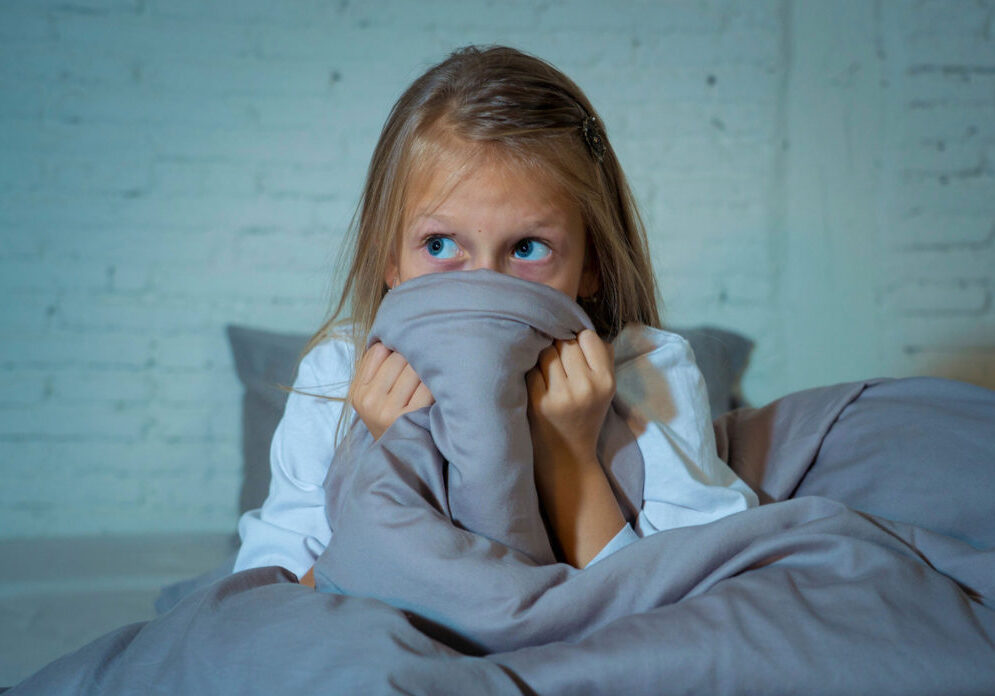Do you talk with your cellphone against your ear? Perhaps you, like many people, carry your cellphone or wireless device in your pocket all day. What about your kids?
With cellphones, iPods, tablets, and laptops now ubiquitous in our modern life, it’s easy to forget that manufacturers cannot guarantee that the amount of radiation emitted by these devices is safe.
Though we are surrounded by wireless devices, many scientists doubt their safety. In 2011, the International Agency for Research on Cancer, part of the United Nations’ World Health Organization (WHO), classified the radio frequency (RF) and electromagnetic fields (EMF’s) produced by cellphones and wireless devices as Class 2B carcinogens – possibly carcinogenic to humans. The Class 2B list also includes lead, chloroform, gasoline fumes, and DDT. Thirty experts from 14 different countries reviewed the research, and the Class 2B designation was nearly unanimous.
The Federal Communications Commission (FCC) requires that cellphones meet RF or specific absorption rate (SAR) exposure guidelines. SAR shows the rate at which humans absorb RF radiation. You can find the SAR for your individual cellphone by entering its FCC ID number into the FCC database at http://www.fcc.gov/oet/ea/fccid. You can review which cellphones have the highest and lowest SAR rates at http://www.cnet.com/news/cell-phone-radiation. Keep in mind that cell phone network technologies can affect radiation exposure as much as phone design, according to research gathered by the Environmental Working Group.
 Currently, every cellphone manual warns to keep the device at a specified distance from the body to avoid exceeding the recommended safe exposure limits of RF/EMFs. However, most wireless device users haven’t read their device’s manual, overlooking important safety information.
Currently, every cellphone manual warns to keep the device at a specified distance from the body to avoid exceeding the recommended safe exposure limits of RF/EMFs. However, most wireless device users haven’t read their device’s manual, overlooking important safety information.
If you place your cellphone against your ear to talk (instead of using an earpiece or its speakerphone), or if you carry your phone close to your body (in a pants or shirt pocket or tucked into a bra) while the phone is on and connected to a wireless network, you may exceed federal guidelines for exposure to RF radiation.
Non-cellular wireless devices (iPads, tablets, laptops, baby monitors, Bluetooth devices, Fitbits, iWatches, and modems) are often left powered on. Although they are not held next to the head like a cellphone, they are continuously emitting electromagnetic radiation in our living space. The FCC advises keeping tablets and laptop computers at least 20cm away from our bodies. Yet how many of us, including kids, use tablets, laptops, iPods, or other devices on our laps?
The potential health effects from these devices have been a subject of controversy for many years, with research supporting arguments on both sides. What is clear is that the technology of cellphone and wireless usage has boomed in recent years (the Environmental Working Group reminds us that the US has more cellphones than people) and long-term effects from widespread use are unknown.
Additionally, a recent study, published November 2015, confirms a significantly higher absorption of cell phone radiation in a child’s brain than in an adult’s brain.
Does the radiation emitted by these devices play a role in causing cancer? In May 2015 the International Electromagnetic Field Scientist Appeal was made to the United Nations, the WHO, and national governments, asking for stricter controls on cellphone radiation. Initially developed by a committee of concerned scientists, the appeal has been signed by 220 independent scientists from 41 nations, who, in total, have written more than 2,000 papers on the topic. In the appeal, these experts point to growing research suggesting that the low levels of radiation from cellphones could have potentially cancer-causing effects.
“I think the overall evidence that wireless radiation might cause adverse health effects is now strong enough that it’s almost unjustifiable for government agencies and scientists not to be alerting the public to the potential hazards,” says David Carpenter, MD, a professor of environmental health sciences at University at Albany, State University of New York. Carpenter is also the director of the university’s Institute for Health and the Environment, a Collaborating Center of the WHO.
Some countries have taken steps to protect wireless users, especially children. France, Russia, the UK and Zambia have either banned ads promoting cellphone use by children or have issued cautions for use by children. Numerous schools have banned or regulated the use of cell phones and wireless devices due to health concerns, including schools in Austria, Germany, Italy, the United Kingdom, Ireland, Canada, India, France, Russia and Israel.
The Centers for Disease Control, the FCC and the National Cancer Institute all maintain that studies have not shown a consistent link between cellphone use and cancer but that more research is needed. Yet the WHO, as mentioned above, classifies RF radiation emitted by wireless routers and cellphones as “possibly carcinogenic.”
What is a concerned parent to do while long-term studies are underway and current science is being debated? If you’re looking to err on the safe side, here are some ways to minimize exposure:
Twelve Ways to Minimize Cellphone and Wireless RF and EMF Radiation
Get wired. Use earphones to talk on your phone. Every inch you can get your device away from your body reduces the amount of radiation you may be absorbing.
Don’t put your cellphone or Wireless device in a pocket close to your body. Use a purse, a belt clip, or a pocket on a backpack. If you have to put a device in your pocket, take it out as soon as possible. Placing your device at arm’s reach dramatically reduces radiation exposure.
Use the speakerphone. If you’re in a private place, put the call on speakerphone.
Don’t wear a Bluetooth device all the time. Wireless earpieces also emit radiation, though less than a cellphone.
Know when your cellphone emits the most radiation and take precautions. A moving phone (i.e., in a car or train) continually attempts to connect as towers come in and out of range, increasing transmitting power and radiation. Cellphones emit the most radiation during the initial connection; wait for the phone to connect before placing it next to your ear. A weak cellular signal also requires your cellphone to work harder, emitting more radiation; limit use when the signal is weak.
Read your user manual. Know what the manufacturer has to say about risks with your device.
Actively manage wireless settings. Set your phone or wireless device to fetch manually so it’s not continuously requesting data. Setting your phone to Airplane mode suspends many of its signal transmitting functions while still permitting use of functions that don‘t require signal transmissions. Turn off your wireless connection when your device is not in use.
Text or email rather than calling. Minimize your device usage and avoid placing the phone next to your head altogether.
Use a land line instead of your cellphone when making longer calls.
Do your research regarding accessories. Studies show that some cellphone cases help reduce radiation, while others increase radiation.
Turn your devices off at night. While you’re resting your bodies, give your family a rest from RF and EMF radiation. Turn off your wireless router, tablets, phones, laptops and computers. Don’t let kids sleep with devices in their rooms, especially if they can’t remember to turn them off. Create a “parking” area for devices, away from sleeping areas.
SOURCES
- Blank, Martin, Magda Havas, Elizabeth Kelley, Henry Lai and Joel M. Moskowitz. “International EMF Scientist Appeal.” EMF Scientist (web). October 15, 2015. http://www.emfscientist.org/index.php/emf-scientist-appeal.
- Deepinder, Fnu, Kartikeya Makker, and Ashok Agarwal. “Cell Phones and Male Infertility: Dissecting the Relationship.” Reproductive BioMedicine Online. June 2007. http://www.rbmojournal.com/article/S1472-6483(10)60338-0/abstract.
- Hinson, Elizabeth. “Cellphone safety: Where do you keep your phone?” CBS News (web). http://www.cbsnews.com/news/cellphone-safety-right-to-know. May 14, 2015.
- Morgana, Lloyd L., Santosh Kesarib, and Devra Lee Davisa. “Why Children Absorb More Microwave Radiation than Adults: The Consequences.” ScienceDirect: Journal of Microscopy and Ultrastructure (web). December 2014. http://www.sciencedirect.com/science/article/pii/S2213879X14000583.
- Schipper, David. “Does Cell-Phone Radiation Cause Cancer?” Consumer Reports (web). September 28, 2015. http://www.consumerreports.org/cro/smartphones/cell-phone-radiation.
- Staff writer. “Cellphones May Be Making You Infertile: Research.” BusinessTech (web). February 6, 2016. http://www.businesstech.co.za/news/mobile/111275/cellphones-may-be-making-you-infertile-research.
- Staff writer. “Cellular Phones.” American Cancer Society (web). December 12, 2014. http://www.cancer.org/cancer/cancercauses/othercarcinogens/athome/cellular-phones.
- Staff Writer. “Does Your Cell Phone Case Raise Your Radiation Exposure?” Environmental Working Group (web). March 3, 2015. http://www.ewg.org/research/does-your-cell-phone-case-raise-your-radiation-exposure
- Staff writer. “NCI Statement: International Agency for Research on Cancer Classification of Cell Phones as “Possible Carcinogen”.” National Cancer Institute (web). May 31, 2011. http://www.cancer.gov/news-events/press-releases/2011/IARCcellphoneMay2011.
- Staff Writer. “New State of the Art Research Shows Children’s Brains Absorb Higher Doses of Cell Phone Radiation Than Adults.” Environmental Health Trust (web). November, 2015. ehtrust.org/new-state-of-the-art-research-shows-childrens-brains-absorb-higher-doses-of-cell-phone-radiation-than-adults/
- Staff writer. “Wireless Devices and Health Concerns.” Federal Communications Commission. November 7, 2015. http://www.fcc.gov/consumers/guides/wireless-devices-and-health-concerns.
- Sutter, John, and Danielle Dellorto. “6 Tips for Minimizing Cell Phone Radiation.” CNN (web). June 8, 2012. thechart.blogs.cnn.com/2012/06/08/6-tips-for-minimizing-cell-phone-radiation-2/.
- Szczerba, Robert J. “Controversial Study Suggests Wi-Fi Exposure More Dangerous To Kids Than Previously Thought.” Forbes (web). January 13, 2015. http://www.forbes.com/sites/robertszczerba/2015/01/13/study-suggests-wi-fi-exposure-more-dangerous-to-kids-than-previously-thought/#75fc0df05fdc.
- Zilberlicht, Ariel, Zofnat Wiener-Megnazi, Yulia Sheinfeld, Bronislava Grach, Shirly Lahav-Baratz, and Martha Dirnfeld. “Habits of Cell Phone Usage and Sperm Quality – Does It Warrant Attention?” Reproductive BioMedicine Online. September 2015.
http://www.rbmojournal.com/article/S1472-6483(15)00300-4/abstract.
Posted in: Health & Nutrition
Comment Policy: All viewpoints are welcome, but comments should remain relevant. Personal attacks, profanity, and aggressive behavior are not allowed. No spam, advertising, or promoting of products/services. Please, only use your real name and limit the amount of links submitted in your comment.
You Might Also Like...

Adverse Childhood Experiences: One Caring Adult Can Make A Difference
Early exposure to trauma and toxic stress (prolonged stress without emotional support) changes the brains and bodies of growing children. When the brain is in survival mode, development is affected […]

A Year Of Healthy Living: Monthly Steps Recommended by the Environmental Working Group to Avoid Toxic Chemicals, Protect Your Health and Save Money
Many parents and families want to live a cleaner, chemical-free life. However, making sweeping changes to incorporate healthier products in your family’s life can seem daunting. But making incremental changes […]

Childhood Nightmares Are Normal
It’s the middle of the night and you’re in a deep sleep. You hear a loud cry of “Mommy!” or feel a touch on your arm. At first you’re not […]

Growing Garden Memories and Good Food At Red Gate Ranch
Two special events in Red Bluff happen each April: The Red Bluff Round-Up and temperatures favorable for summer garden planting. It took much trial and error in our family’s garden […]



